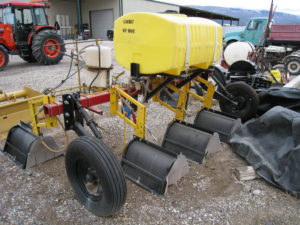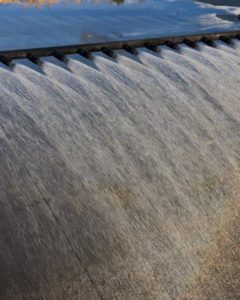Description
Boom sprayers mounted on ATVs, pickups, tractors, trailers, or self-propelled vehicles are useful on relatively smooth, unobstructed rangeland. Booms can vary from simple shop-built units to manufactured units that are self-leveling, compensate for vibration, and fold for transport. Sprayers consist of a tank, pump, pressure gauge and relief valve, nozzles evenly spaced along a boom, and hoses. Tanks that hold the liquid spray solution are plastic, fiberglass, or stainless steel. Pumps are gear, piston, diaphragm, or centrifugal type. Pumps are powered by a tractor power-take-off, hydraulic or electric motor, or a small gasoline engine. Nozzles are available that distribute the spray solution in a variety of patterns, e.g., flat-fan, solid-cone, or hollow-cone shapes. Numerous types of controllers including GPS units are available to enhance the precision of spray applications. Some boomless sprayers use a nozzle body with a cluster of nozzles to distribute the spray solution over a 15- to 30-foot-wide swath. The FieldJet KLC-5 or KLC-9 nozzle (Spraying Systems Company) is a single, small nozzle that distributes the spray over a 15- to 18-feet-wide swath. Another style of boomless sprayer is a mist blower. It uses a blast of air around several nozzles to carry the spray over the target area.
Application
Boom sprayers are useful for treating weeds or small shrubs (less than 4-feet tall) where obstructions do not restrict the boom. Boomless sprayers are used where booms are impractical. Boomless sprayers generally must be used when winds are relatively calm. Nozzle manufacturer’s websites or catalogs list nozzle types, sizes, spray patterns, nozzle spacings and height placements, and outputs in gallons/minute at various pressures. Many nozzles are color coded to prevent the use of an improper nozzle size. Spray output and speed determines application rate (gallons/acre [gpa]) which is usually 10 to 20 gpa for ground spraying. Production rates (acres/hour) vary widely depending on the width of the boom and speed of the sprayer. Ground spraying gives uniform coverage with minimal drift. However, caution should always be observed for potential drift from the target area. Mist blowers have very strict regulations for herbicide applications; they are used more for orchard spraying. Rangeland ground spraying is practical on sites of less than 200 acres or where aerial applications are not available or feasible. State pesticide applicator licenses are required if restricted-use herbicides are used. All applications should follow the chemical’s Product Label. An innovation is spraying herbicide on the blade of a shredder for a stem application at the time of cutting. Additional information available in the Shredder and Rotobeater section.
Images
References / Additional Information
Stevens, R.; Monsen, S.B. 2004. Chapter 9. Mechanical plant control. In: Monsen, S.B.; Stevens, R.; Shaw, N.L., comps. Restoring western ranges and wildlands, vol. 1. Gen. Tech. Rep. RMRS-GTR-136-vol-1. Fort Collins, CO: U.S. Department of Agriculture, Forest Service, Rocky Mountain Research Station. p. 65-88.








